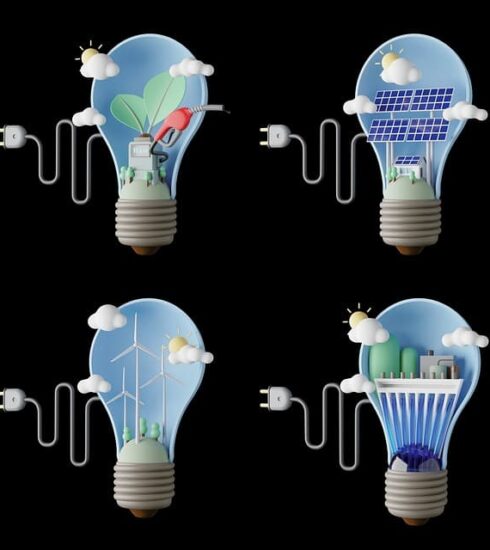Why is Renewable Energy Becoming So Cheap, and What Could It Lead To?
Some 10-15 years ago, “green energy” seemed like an entertainment for rich and wealthy countries: the cost of energy generated by wind turbines and solar power plants was incomparably higher than the cost of a kilowatt hour generated by burning fossil fuels. Reducing the greenhouse effect, minimizing emissions, and other environmental arguments often fell by the wayside when it came to the economic component: after all, what is the point of building a solar plant if the energy from it will be much more expensive than, for example, from coal…
But then a quiet revolution took place before our eyes. For 10 years the cost of energy from renewable sources has fallen by several times and became equal to conventional energy (and even lower!), while the price of energy from fossil fuels has remained at about the same level, and in the case of nuclear energy, on the contrary, has increased.
Price as a determining factor
Today, fossil fuels – coal, oil, and gas – account for about 79 percent of the world’s energy production.
Fossil fuels contribute 87% of the global CO2 emissions, endangering not only our descendants, but the entire biosphere. And it is responsible for the deaths of many people today: 3.6 million people worldwide die each year from these emissions. That is six times more than deaths from murder, wars, and terrorist attacks combined.
Obviously, alternatives to fossil fuels, such as renewables and nuclear power, are orders of magnitude safer and cleaner.
But why then does the world economy still rely on fossil fuels?
The answer is simple: the reason is that this type of fuel has long been the cheapest. Cheaper than all other energy sources. This is why coal still provides 37% of the world’s electricity today. In second place is gas (24%). And together they are the largest source of greenhouse gas emissions, producing 30% of global emissions.
Over the last 10 years nuclear power has become more expensive, gas has become cheaper, and the price of coal has remained almost unchanged. Look at how dramatically the cost of renewable energy has changed recently. Just “yesterday,” 10 years ago, it was much cheaper and more rational to build another coal-fired power plant than to bother with solar or wind generators. “Wind” was 22% more expensive than coal, and “solar” was as much as 223% more expensive.
However, a lot has changed in the past 10 years. In not too distant 2009, electricity from photovoltaics cost $359 per MWh, and now it’s 89% less. And the best part: now, in order to recoup the cost of building a new coal-fired power plant, you will have to charge your end users a higher price for energy than if you were to build a wind or solar power plant of similar capacity.
This is truly a fundamental change – and it has certainly had an impact on the electric power industry. In recent years, wind and solar power have evolved rapidly: in 2019, it was already 72% of all new capacity commissioned.
The fact is that the cost of producing energy from fossil sources (as well as nuclear power) is essentially influenced by two factors:
The cost of the fuel itself;
The operating costs of the power plant.
In contrast, with RES, fuel is “free”: it does not have to be extracted from the ground and transported. And the operating costs are much lower. The main factor determining the cost of RES is the production technology itself.
From Space Prices to Mass Market
Let’s make a little excursion into the past and remember the path of photovoltaics. One of the first references to the cost of solar electricity dates back to 1956. At that time it was $1865 per watt (in 2019 prices and adjusted for inflation). But one watt is nothing. A notional modern solar panel mounted on the roof of a house produces about 320 watts, and at that price in 1956 it would have cost us as much as $596,800. Of course, competitiveness was out of the question here.
But thanks to space research. It enabled the first practical application of solar energy: In 1958, the American satellite Avangard I was equipped with a solar cell. Throughout the 1960s, the space industry remained the main consumer of photovoltaics. Demand grew, so did production, and technology was gradually optimized. As a consequence, the cost of solar modules slowly but steadily declined.
In the 1970s, “space technology” finally came down to earth. The first terrestrial applications of solar panels were attempts to electrify hard-to-reach places, which were too expensive to connect to conventional power grids: lighthouses, railroad crossings. Note that the total global solar power generation at the time was about 0.3 MW. This, of course, was already unheard of progress (compared to 1956, the price had dropped by 94%!), but 0.3 MW – alas, still far from industrial scale.
But in fact, everything was just beginning… While the input of new capacity was growing exponentially – the cost of solar modules was exponentially decreasing. The wider production became, the cheaper the products became, which, in turn, led to even greater production growth – the same economies of scale that we see almost everywhere. Plus, of course, government support helped, which through subsidies was able to lower the price in the early, most expensive stages.
The advances that have made this reduction in the price of solar panels possible are essentially about the entire production process. Facilities have become larger and more efficient; R&D has become more effective; silicon wafer production has improved; raw material extraction has expanded; modules have become stronger and more durable; competition has increased; and capital costs of production have fallen. These and many other large and small improvements formed the overall process that led to a steady decline in production costs.
If we take as a kind of “learning curve” the rate of cost reduction as production doubled, in the case of solar cells it was 20.2%. Manufacturing technology has rapidly become cheaper, and between 1976 and 2019, the cost of batteries fell from $106 to $0.38 per 1 watt produced. A similar exponential change in the “learning curve” is familiar to us from other technologies: the most famous example is the cost of computers (processors) and the famous “Moore’s Law”.
But we are more interested in the prices not of solar panels, but of the electricity they produce. The cost of green electricity decreases exponentially as its production increases. With each doubling of production, the cost per watt decreases by 36% (for solar power) and by 23% (onshore wind power). But energy from offshore wind power plants is still relatively expensive – only a quarter cheaper than nuclear power and slightly more expensive than coal. Nevertheless, experts expect the cost of this type of energy to decrease rapidly in the next few years, primarily due to an increase in the size of turbines and greater utilization due to constant wind.
Thus, the production of electricity from RES shows a dynamic of rapid and steady decline. What about conventional energy?
The global price of coal fell from $111 to $109 from 2010 to 2019, i.e. by only 2% – against a background of 89% cheaper solar and 70% cheaper wind. The stagnation of coal-fired electricity prices over the past 10 years is not surprising. Historically, its cost dynamics never followed a “learning curve”: it was and still is relatively cheap. But it won’t get any cheaper in any serious way. Firstly, modern coal-fired power plants have little room for serious growth in efficiency: the most efficient plants achieve an efficiency of 47%, while the average efficiency is about 33%. Secondly, the price of coal-fired power is largely determined by the cost of raw materials, which accounts for up to 40% of total production costs. Even if the price of erecting coal-fired plants drops significantly and their efficiency increases, the price of fuel will still block the dynamics of cost reduction.
On the contrary, the price of electricity from gas has fallen by 32% to $56 per MWh over the last 10 years. One of the reasons is the reduction of the cost of construction of processing plants. But another reason is much more important: the significant decrease in the price of gas itself as a raw material after the peak in 2008 – including due to the growth in supply with the technology of hydraulic fracturing. However, this drop in the price of raw materials is temporary: the price of gas is actually higher today than it was two or three decades ago. It is unlikely to continue in the future, and there is obviously no “learning curve” to the cost of gas-fired electricity.
Nuclear power, in general, has become more expensive, and this trend will continue in the long term. The construction of nuclear power plants has become more expensive, partly because regulation of the industry has become stricter. In addition, not so many new NPPs have been built in recent years, and as a result, there were no economies of scale. Therefore, the average global cost of nuclear power (as the NES) has generally increased. This, however, does not cancel out the fairly large variation in price trends between individual countries and regions. For example, while in the United States and Great Britain the prices and the time of construction of plants have increased significantly, in France and South Korea they remained at the same level. According to a number of experts, those countries where reactor construction is more standardized have been able to avoid price hikes. If standardization becomes widespread and the growth in the number of new nuclear power plants stops stagnating, it is likely that the cost of nuclear power will go down. It is unlikely that it will ever reach the exponential dynamics of the cost of renewable energy, but it can effectively complement renewable energy where the latter faces problems. Plus we should not forget about the possible prospects of thermonuclear reactors, which theoretically can completely change the world’s energy supply system.
Conclusion
So why is renewable energy getting so cheap? As the above arguments suggest, the main feature that dramatically distinguishes renewables from fossil fuels is that their cost follows an exponential “learning curve.” Renewable power plants do not require the cost of the fuel itself and are relatively inexpensive to operate and maintain. Their price (NSE) depends solely on the cost of technology. And these technologies – whether solar power, wind power, or storage technologies – follow a “learning curve”: each doubling of capacity leads to a corresponding decrease in costs. The more widespread wind and photovoltaic generators become, the faster their costs fall.
Thus, the more green energy we implement today, the more we will be able to implement tomorrow due to lower costs. Accordingly, by expanding the use of renewable energy sources, we will simultaneously solve two problems: reduce the negative effects of emissions and the greenhouse effect, and, perhaps even more importantly, obtain cheaper electricity. Ultimately, this will lead to higher real incomes, economic growth and poverty reduction.





